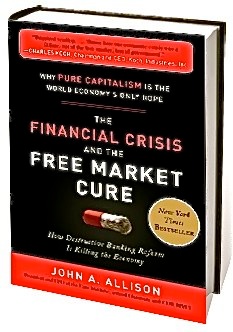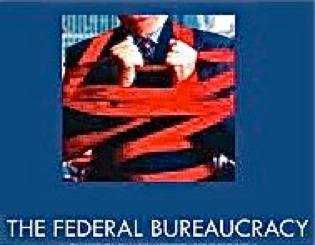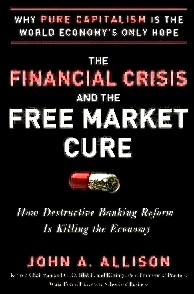The Financial Crisis and the Free Market Cure
Some things are possible but highly unlikely to occur. One of those unlikely events may be unfurling at this moment.
President Obama announced that he was going to reduce the federal government’s role in the mortgage market. To do that, he intends to overhaul Fannie Mae and Freddie Mac by reducing their portfolios and remove the implicit guarantee of a government bailout.

This indicates that another unlikely event may have already occurred. It is possible that the President or one of his close advisors studied John A. Allison’s The Financial Crisis and the Free Market Cure.
Allison knows intimately the subject of his book. He has been there and done that. His 20 years as Chairman and CEO of Branch Banking and Trust makes him the longest serving CEO of a major financial institution. He is now CEO of the Cato Institute.

His 254 page book gives names and cites chapter and verse from the play bill of federal agencies and officials who enabled, encouraged, and facilitated procedures and practices that led to the real estate/banking bubble and bust.
He traces the birth and nurture of a right to home ownership from the creation of Fannie Mae during Roosevelt’s New Deal in 1938. This humble beginning metastasized through the Federal Deposit Insurance Act, Freddie Mac, the sub-prime market, pick-a-payment mortgages, fair-value accounting and many more programs and procedures to a huge glob of over-built, over-priced homes housing families that could not afford them.

One chamber of the heart of this problem was greed. Some bankers and mortgage brokers like Country Wide Loans were greedy. They felt safe in satisfying that greed because they and their investors knew the FDIC and, later, a similar program for Saving and Loan Associations, were secure safety nets. This encouraged them to seek home buyers who wanted to keep up with the Joneses and buy the largest house on the block without regard to whether they could afford the house. Hence the pick-a-payment and subprime mortgages.
Allison blames the collapse of this system squarely on the federal bureaucrats and their laws and regulations promulgated by individuals who had no clue as to how a market left open to free competition without government guarantees would have performed.

The ultimate culprit is portrayed in the following long paragraphs in words much better than I could have cobbled together because I, like the bureaucrats he describes, do not know enough about banking and accounting to be that articulate.
“In my career in banking, there have been very few, if any, occasions when the financial regulators identified a problem bank and acted in advance to correct the problems. In fact, in almost every case of bank problems or failures, government regulators have been the last people to know. They almost always ‘close the stable door after the horse has been stolen.‘ The belief that regulators will somehow act differently in the future is extraordinarily naive. It shows a deep lack of understanding of human nature and the power of incentives. It also reflects a lack of understanding of the information available to regulators to make decisions and their ability to integrate this information.
“The bank regulatory agencies are dominated by lifetime government bureaucrats. The way to be successful in this environment is to follow the rules and not rock the boat. The environment is often routine, stifling, and anti-innovative. It is very process-oriented and mechanical. The best and brightest individuals tend to leave. Those who stay develop a more and more bureaucratic mindset over time.
“The regulatory agencies have enormous power, and in a broad context they make the law. Congress often passes ‘sound good, motherhood and apple pie laws, which regulatory agencies convert to the real law. The courts seldom override the decisions of the regulators. Even if it is fairly clear that the regulators have misinterpreted or simply made up a law, it could take years for a bank to prevail in court. In the meantime, the regulators can put the bank out of business. Very few banks (businesses) will go to court against their regulators on important issues, especially issues that affect only one or a few banks. Most legal battles are fought by some form of association.
“The government regulators leave themselves tremendous leeway to interpret their own regulations. Sometimes they enforce a regulation; sometimes they do not enforce the same regulation. A very typical strategy is to enforce regulations after the fact.…
“The regulatory process is also extremely political, and therefore there is no objective rule of law for businesses that are subject to heavy regulation….” (pp 40-41)
So here’s the perspective.
This is a very short summation of an extremely detailed and technical book. Reading the entire 254 pages lends to an understanding why some people think the government is too big already.

enough





